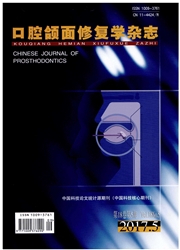

 中文摘要:
中文摘要:
目的:研究皮肤真皮多能干细胞诱导后成牙分化的可行性,以期为组织工程再生牙齿探寻一种可靠的成体干细胞。方法:使用大鼠胚胎期发育牙胚制备条件培养基,诱导皮肤真皮多能干细胞分化,检测诱导后细胞增殖变化、矿化能力以及体外检测基因表达和细胞表型。结果:大鼠胚胎期发育牙胚细胞条件培养基诱导皮肤真皮多能干细胞后,皮肤真皮多能干细胞增殖加快、矿化能力增强,同时,诱导组细胞中可检测到ALP、OCN、BSP mRNA以及DSP和DMP-1 mRNA的表达,进一步细胞表型分析显示,诱导组皮肤真皮多能干细胞表达DSP、DMP-1以及ALP阳性。结论:利用发育早期牙胚细胞分泌的信号分子在体外模拟牙胚发育的微环境,使得皮肤真皮多能干细胞实现了向牙源性间充质细胞方向的表型转化。
 英文摘要:
英文摘要:
Objective: To explore the possibility of utilizing dermal multipotent cells (DMCs) from skin tissue for odon-togenic induction. Methods: By in vitro exposure to conditioned medium of embryonic tooth germ cells in culture, the proliferation and mineralization activity of DMCs was assessed. The odontogenic ability of conditioned-medium-treated DMCs was evaluated by gene and protein experiments. Results: The proliferation and mineralization activity of DMCs was elevated while the embryonic tooth germ cell conditioned medium (ETGC-CM) showed significant effects. ETGC-CM treated DMCs phenocopied the odontoblasts in vitro as indicated by specific lineage markers. Conclusion: The isolated single-colony derived DMCs showed certain stem cell properties indicating that DMCs possessed the characteristics of mes- enchymal stem cells, suggesting the potential utility of DMCs as an alternative candidate cell source in tooth regeneration research.
 同期刊论文项目
同期刊论文项目
 同项目期刊论文
同项目期刊论文
 期刊信息
期刊信息
